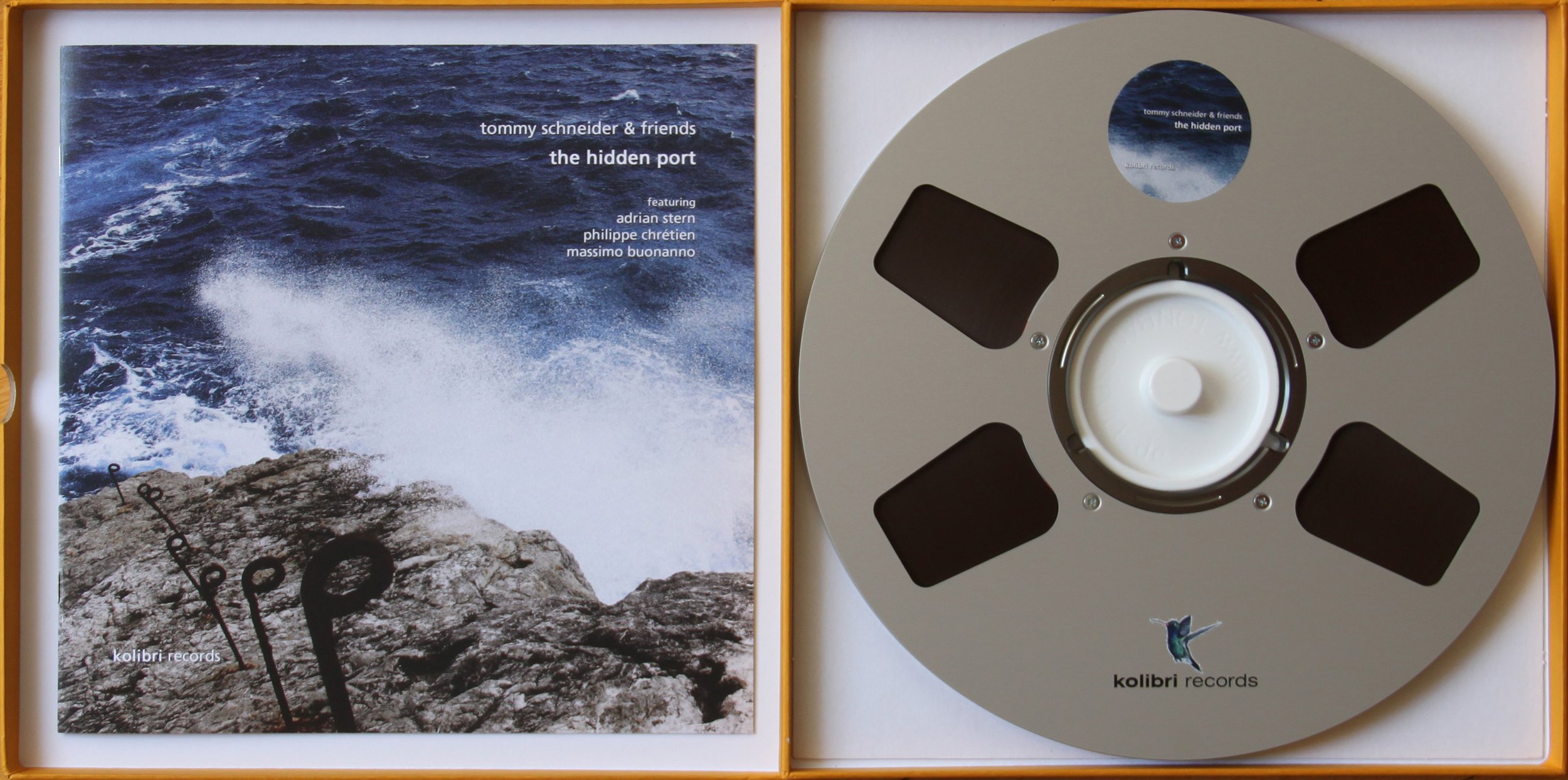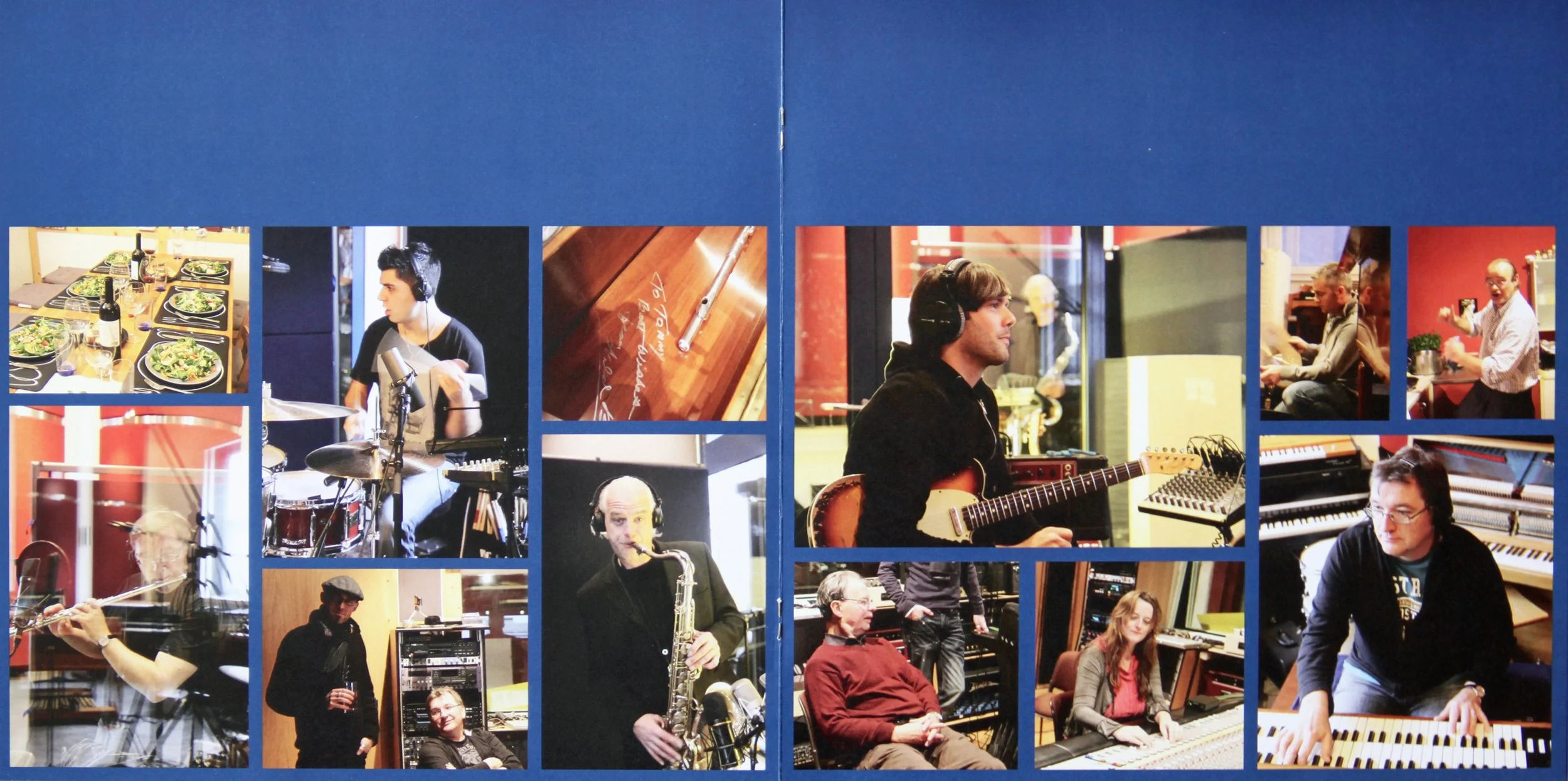Tommy Schneider & Friends - The Hidden Port
Publisher: Revox Horch House
Playing time: 36 min
Specifications: half track ¼", stereo, RTM SM900, CCIR, 510 nWb/m, 38 cm/s
Reel(s): 1 high quality metal reel, printed, with stickers
Packaging: 1 special cardboard box, with stickers, with spine labeling
Inserts: 1 booklet with 8 pages
Homepage: https://www.horchhouse.com/
Information: The production of the audio tape was taken over by Revox Horch House
Author: Claus Müller
The 2012 album "The Hidden Port" of the formation "Tommy Schneider & Friends" in the line-up Adrian Stern (guitars, percussion), Philippe Chrétien (saxophone) Massimo Buonanno (drums, percussion) and Tommy Schneider (Hammond organ, flute, percussion) was released in April 2023 as a master tape copy. On the compilation "The Best Of" released in 2019, available only as a master tape copy, are the tracks "The Hidden Port" and "Take Five", that is, two of the eight tracks of the album "The Hidden Port".
In April 2023, at the Analog Forum of the German Analogue Audio Association (AAA), I met composer, producer, musician, bandleader, Hammond organ specialist and owner of the Kolibri Records label, Tommy Schneider, for an interview.
Claus: Tommy, you are a "keyboard player", especially for Hammond organs as well as a flutist. How did the love for this keyboard instrument come about and how was the way that you take care of the restoration, give lessons and run your own store "Hammond Times" in Zurich (Switzerland)?
Tommy: Since I was nine years old I had a classical education on the flute and played in a youth orchestra. At some point they were looking for a timpanist. At the same time, I started learning drums and playing in a band. Here I learned to play independently with my hands and feet, which was very helpful for later operating the Hammond organ. With the drums I was missing something melodic. Then I saw a self-built organ by Wersi at an exhibition and was completely thrilled. Since I was not a technician at that time, a friend of my father's recommended that I buy an original Hammond organ with a Leslie cabinet. I went to a school in Ticino. There were several of these instruments there and then I was hooked. The subject has not let me go until today. Soon the hobby became a profession. After building up international contacts, I had access to many spare parts. In the early years, the German "Hammond Nostalgie Club" was also important for me. This was the place for me where like-minded people could exchange information and there were also many spare parts being offered around. This was all still in the pre-internet era. In 1994 I founded my own store "Hammond Times" in Zurich.
Claus: The Hammond organ was a very popular instrument in the 1970s. It can be heard on very many rock albums. The sound spectrum fascinates the listener, and the instrument was often used as a soloist. You told me that each Hammond organ has its own sound characteristics. I would be interested to know what these are exactly and how they were and are dealt with?
Tommy: Basically, each Hammond organ is unique because it is a mechanical instrument. The sound depends on many factors, such as the tone generator, the tubes, and the Leslie tone cabinet used, and whether the organ was played a lot or a little, who played it, whether it was played more in low registers or high registers, with few stops or with a lot of stops. All this has some influence on the sound. When playing the Hammond organ, a lot also depends on the volume pedal, which is what you do all the dynamics with. In hard rock music, the volume pedal is usually at maximum. In jazz, there's a lot of work in the pedal, the right foot practically never stands still. The left foot often plays the bass pedal, which is also a peculiarity of the organ. Sometimes you play the bass only with the foot, sometimes only with the hand (this is also possible) and sometimes with both together. This then results in a special bass sound. It's like you're playing legato with your left hand, so you're tying the bass notes, and with your left foot you kick the pedals very briefly and then you get this groove that can make people automatically clap along or tap their feet. When I play, I can see right away if I'm reaching people. In a rock band, you usually have a bass player and only play on the two manuals. Back to the characteristic: If you are looking for a certain sound, then you have to search until you find an appropriate instrument. There are organs that sound more wooden and those that sound more metallic. I love the wooden ones, for sure. Although digital organs are very good today, they never quite achieve the individual sound of the original instruments. If I can choose, I always go for an old instrument. At this point, however, it must also be said that the original organs weigh around 180 kg, while their digital siblings only weigh around 20 kg.
Claus: What is the status of the Hammond organ today? Are there still many good instruments on the market? Are they still in demand?
Tommy: Unfortunately, the demand is no longer very great. I wish there was more interest among the new generation. The numbers of good organs are declining. I increasingly come across instruments that are in poor condition. If they are not played for a long time, the stand damage comes, the old story. You have to see, they are now around 60 years old. The best years of building Hammonds were perhaps from 1957 to 1962. The Hammond B3 (the most built model) was built from 1955 to 1974.
Claus: How did the idea of producing your own albums come about during your career as a musician? There are currently six of them, if you count "The Best Of". Can the world of music lovers expect more productions?
Tommy: With me the desire was always there to produce an own record. In 1989 I released a first single. The band SOS was formed at the end of 1996 and the first album was produced already half a year later. We played very intensively at that time, had enough songs together and we were already in the studio. The recording was live and analog. Later, I had the desire to create my own album. My own stuff is a little less jazzy and goes more in the direction of blues, soul, funk or even rock, also because of the guitar. My desire is clearly there to make something fine once again. It should definitely be an analog production, with own songs as well as maybe again with a few cover versions.
Claus: I find it impressive that the predominant compositions come from you. In which moments do they arise and how do they become the finished product?
Tommy: The own songs arise mostly spontaneously or from a concrete idea. For the albums "Plan B3" and "The Hidden Port" we met in the studio, I presented the songs (partly unfinished) and each musician could bring in his own ideas or contribute to the arrangement. This approach often resulted in an exciting snapshot. If you rehearse something for a very long time, it's absolutely tough, but maybe a little too tough. The spontaneous live recording has its own charm.
Claus: I would now like to pivot to your album "The Hidden Port", which is currently released as a tape. How did this album come about?
Tommy: I decided in advance which covers we would play and told the musicians. For songs like that, everyone then comes to the studio prepared. We didn't even rehearse the track "Take Five" together, but started recording right away. We wanted to see what would happen. It was easy to see the result when the thumbs went up in the control room. So it was a done deal already at the second attempt.
Claus: In my review of the tape "the best of" in the analog 03/2020 the original files of the different albums were brought into the same tonal balance by Dan Suter (ECHOCHAMBER). Was the material for "The Hidden Port" also post-processed before it could be released on tape?
Tommy: No, on the contrary. We copied directly from the digital master to tape. We tried different CD machines. Finally, we took the original master CD, put it in a Studer machine and transferred it to the Telefunken M10A. In between is a special tube preamplifier that can be used solely for this purpose. This makes the music sound very real and analog. We started different experiments until we had the best result.
Claus: I would like a statement about audiotape in general. In your opinion, what sets this medium apart from other sound carriers or digital files?
Tommy: You have more spaciousness with tape, for me the bass is more present. The highs are less thinned out than on record or digital. Tape always has a little bit more at the corners and ends. The space is a little higher, a little wider, a little deeper, depending on the recording. The tape gives you something organic. It's something physical, but that has nothing to do with volume. The total package of the music comes to you. However, the digital world also has its advantages and justification (editing, quick access, quick recording possibility if there is a spontaneous idea, etc.).
Claus: Thank you very much for this interview.
The title "Funky Journey" sets the agenda for the entire album with notable excursions into blues, rock and jazz. The tracks "Ronnies Bonnies", "Cold Duck Time", "Wave Dance" and "Breakfast At Sprüngli's", were wonderfully interpreted with electric guitar and saxophone solos and a Hammond organ that is always played appropriately. The title track, "The Hidden Port", has the makings of a hit: the flute introduces a ballad that leads into a rocking core. "Take Five" impresses with a slow and forward rhythm. "Ocean Blues" ventures into blues rock without neglecting the funk and jazz. The tough bass line played by Tommy Schneider on the Hammond organ is striking. You can hear how well the four musicians harmonize and interact. The band leads very relaxed through the program. From the tape comes a round piece of album art to celebrate, really well done! I am happy about this stroke of genius, which enriches the tape world. For me a "must have" with a very high enjoyment factor, including addiction potential.
Author's Note, August 31, 2023: This review was written before it was announced that TRISTON's tapes will be released by the publisher Horch House in September 2023.
Translated from German with www.DeepL.com (free version)
Music:
Sound:
The entire content and the individual elements of the web page are the intellectual property of Claus Müller and are subject to copyright protection. They may not be copied or imitated in whole or in part by the user; this applies to texts, logos and image components. Any modification, duplication, distribution or reproduction of the website or parts thereof, in any form whatsoever, is not permitted without the prior written consent of Claus Müller.
Der gesamte Inhalt und die einzelnen Elemente dieser Webseite sind geistiges Eigentum von Claus Müller und unterliegen dem Schutz des Urheberrechts. Sie dürfen vom Nutzer weder kopiert noch im Ganzen oder in Teilen imitiert werden; dies gilt insbesondere für Texte, Logos und Bildbestandteile. Jegliche Veränderung, Vervielfältigung, Verbreitung oder Wiedergabe der Webseite sowie Teilen hiervon, gleich welcher Art, ist ohne vorherige schriftliche Zustimmung von Claus Müller nicht zulässig.






